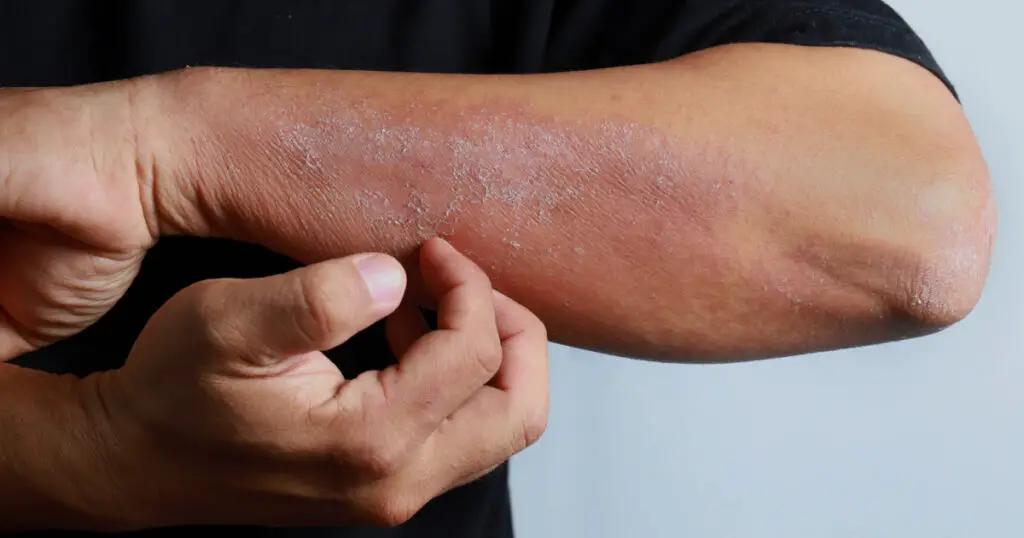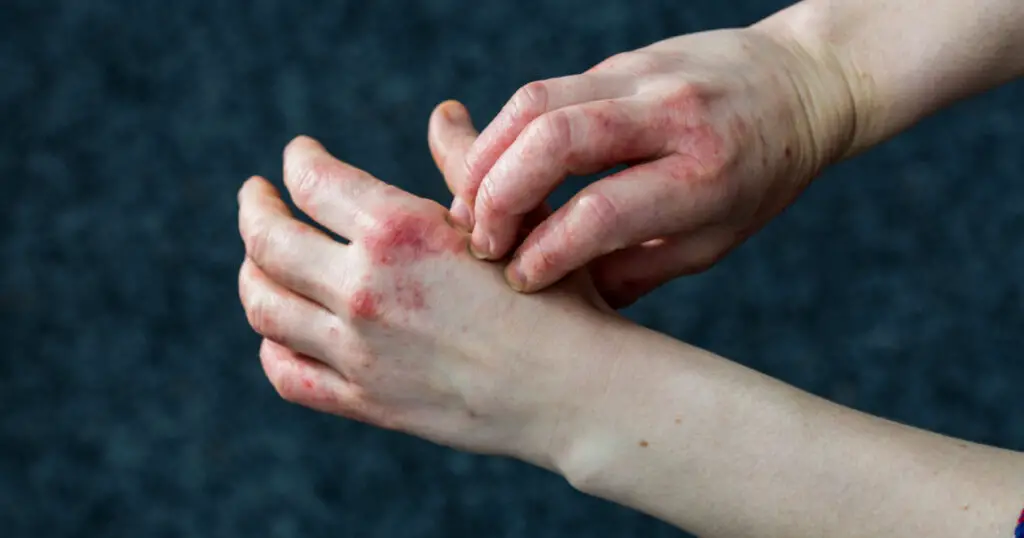If you’ve noticed small, painful red bumps on your skin that are causing discomfort, you may be dealing with dyshidrotic eczema. While this condition isn’t curable, it is manageable and can be kept under control with proper care. In this article, we will explore the causes, symptoms, and treatments for dyshidrotic eczema, a common skin condition that affects many people, especially during springtime.
What is Dyshidrotic Eczema?
Dyshidrotic eczema, also known as pompholyx or vesicular hand dermatitis, is a chronic skin condition that causes deep, itchy blisters to form on the hands and feet. The blisters typically appear on the edges of the fingers, toes, palms, and soles of the feet. These small, fluid-filled bumps can lead to redness, swelling, and intense itching, which can be very painful. Although this condition isn’t contagious, it can become infected, which can delay healing.
Dyshidrotic eczema is not a single disease but rather a form of eczema—a group of diseases that cause skin inflammation. Eczema is more common than most realize, affecting an estimated 35 million people in the United States alone. Among those affected, around 70% are children under the age of five. The exact cause of dyshidrotic eczema is not fully understood, but it is believed to be linked to genetic factors, allergies, and environmental triggers.
 Shutterstock
Shutterstock
Symptoms of Dyshidrotic Eczema
The symptoms of dyshidrotic eczema can vary from person to person, but the most common signs include:
- Deep-set blisters: These appear on the palms, fingers, toes, and soles of the feet. The blisters are usually small (1–2 mm) and can eventually dry out, leaving behind scaly skin.
- Itching: The affected areas are extremely itchy, which can lead to scratching and further irritation.
- Redness: The skin around the blisters becomes red and inflamed.
- Flaking and cracking: As the eczema heals, the skin may become dry, flaky, and cracked.
- Pain: The blisters can cause significant discomfort and pain, especially if they become infected.
People with a history of contact dermatitis, atopic eczema, or hay fever are at a higher risk of developing dyshidrotic eczema. Additionally, certain environmental factors such as exposure to irritants or stress can trigger flare-ups.
 Shutterstock
Shutterstock
Causes and Risk Factors of Dyshidrotic Eczema
While the exact cause of dyshidrotic eczema is unknown, several factors are thought to contribute to its development:
- Genetics: A family history of eczema or other skin conditions increases the likelihood of developing dyshidrotic eczema.
- Allergic Reactions: Exposure to allergens, such as certain foods, dust mites, or pet dander, may trigger flare-ups in individuals with sensitivities.
- Stress: Emotional stress is a common trigger for many people with eczema.
- Environmental Irritants: Prolonged contact with water, harsh soaps, or chemicals can irritate the skin and worsen symptoms.
- Infections: Bacterial infections can sometimes complicate eczema and prolong the healing process.
Treatment for Dyshidrotic Eczema
Although there is no cure for dyshidrotic eczema, several treatments can help manage symptoms and reduce flare-ups. These treatments can be broadly categorized into conventional medical treatments and natural remedies.
Conventional Treatments
- Corticosteroid Creams and Ointments: These are often the first line of defense against dyshidrotic eczema. They help reduce inflammation, swelling, and itching. In some cases, oral corticosteroids or injections may be prescribed for more severe flare-ups.
- UV Light Therapy: Exposure to ultraviolet (UV) light can help reduce the severity of eczema symptoms by calming the skin’s immune response. This treatment is typically performed under the supervision of a dermatologist.
- Antihistamines: These may be used to alleviate itching and reduce inflammation.
- Anti-Itch Creams: Over-the-counter or prescription anti-itch creams can help soothe irritated skin.
- Immune-Suppressing Ointments: Drugs like Protopic and Elidel can help regulate the immune system’s response and reduce inflammation in severe cases.
Natural Remedies
In addition to conventional treatments, many individuals with dyshidrotic eczema find relief using natural remedies. These remedies can help soothe the skin and reduce inflammation without the side effects associated with medications.
- Cold Compresses: Soaking a cloth in cold water and applying it to the affected area for 15 minutes can help reduce swelling and itching. Repeat this process two to four times a day and follow up with a moisturizer to keep the skin hydrated.
- Aloe Vera: Known for its cooling and soothing properties, aloe vera gel can help reduce inflammation and promote healing. Apply fresh aloe vera directly to the skin or use aloe-based creams available at pharmacies.
- Oatmeal Baths: Oatmeal has natural anti-inflammatory properties that can help alleviate the itching and discomfort associated with eczema. Adding colloidal oatmeal to a lukewarm bath can provide relief and soothe the skin.
- Moisturization: Keeping the skin moisturized is crucial for managing eczema. Use fragrance-free, gentle moisturizers to lock in hydration and protect the skin from further irritation.
Preventing Dyshidrotic Eczema Flare-Ups
While it may not be possible to prevent dyshidrotic eczema entirely, there are several steps you can take to minimize flare-ups:
- Avoid Triggers: Identify and avoid factors that trigger your eczema, such as certain foods, allergens, or stress.
- Gentle Skincare: Use mild, fragrance-free soap and avoid hot water when washing your hands or body. Pat your skin dry with a soft towel to avoid irritation.
- Wear Protective Gloves: If you frequently come into contact with water or irritants, wear rubber gloves to protect your hands.
Conclusion: Managing Dyshidrotic Eczema Effectively
Although dyshidrotic eczema can be a persistent and uncomfortable condition, it is manageable with the right treatments and lifestyle changes. By following a consistent skincare routine, using appropriate treatments, and avoiding known triggers, individuals with this condition can lead a relatively normal life. If you suspect you may have dyshidrotic eczema, it is important to consult with a dermatologist for a proper diagnosis and treatment plan.
For more information on skin conditions and their treatments, check out the following articles:
Full Story: Man Loses 360 Pounds Naturally, Internet Rallies to Support His Next Step
Related Article: Tammy Hembrow’s Bikini Photos Stirring Controversy
This article uses strategic SEO techniques to help increase visibility, focusing on key keywords related to dyshidrotic eczema and skin care treatments. Additionally, the inclusion of helpful external links encourages further reader engagement.